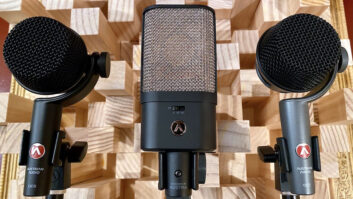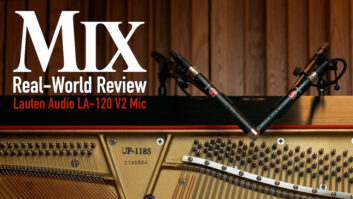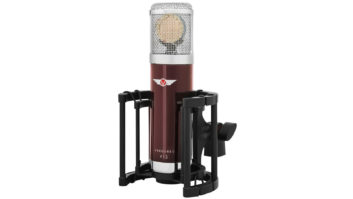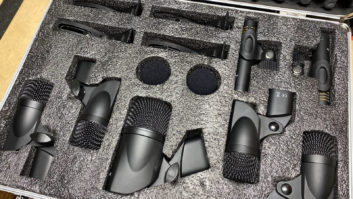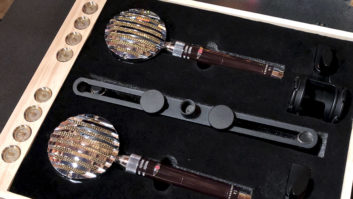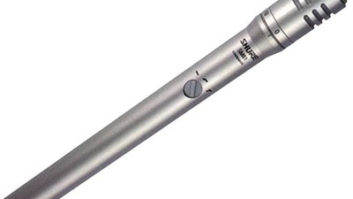Microphones are like good friends: You can’t have too many trusted ones. The mics tested here bring sonic excellence across a wide range of applications. The sE8 from sE Electronics is a front-address model that comes as a single unit with a clip mount, or a stereo pair shipped in a sturdy case with a stereo bar, clips and foam pop filters. The EHR-T from Swedish manufacturer Ehrlund uses an impressive triangle-shaped capsule and ships in a foam-lined wooden box with a sliding top. It comes with a stand clip and multi-pinned cable that splits to front, and back, 3-pin male XLRs.
SEELECTRONICS SE8
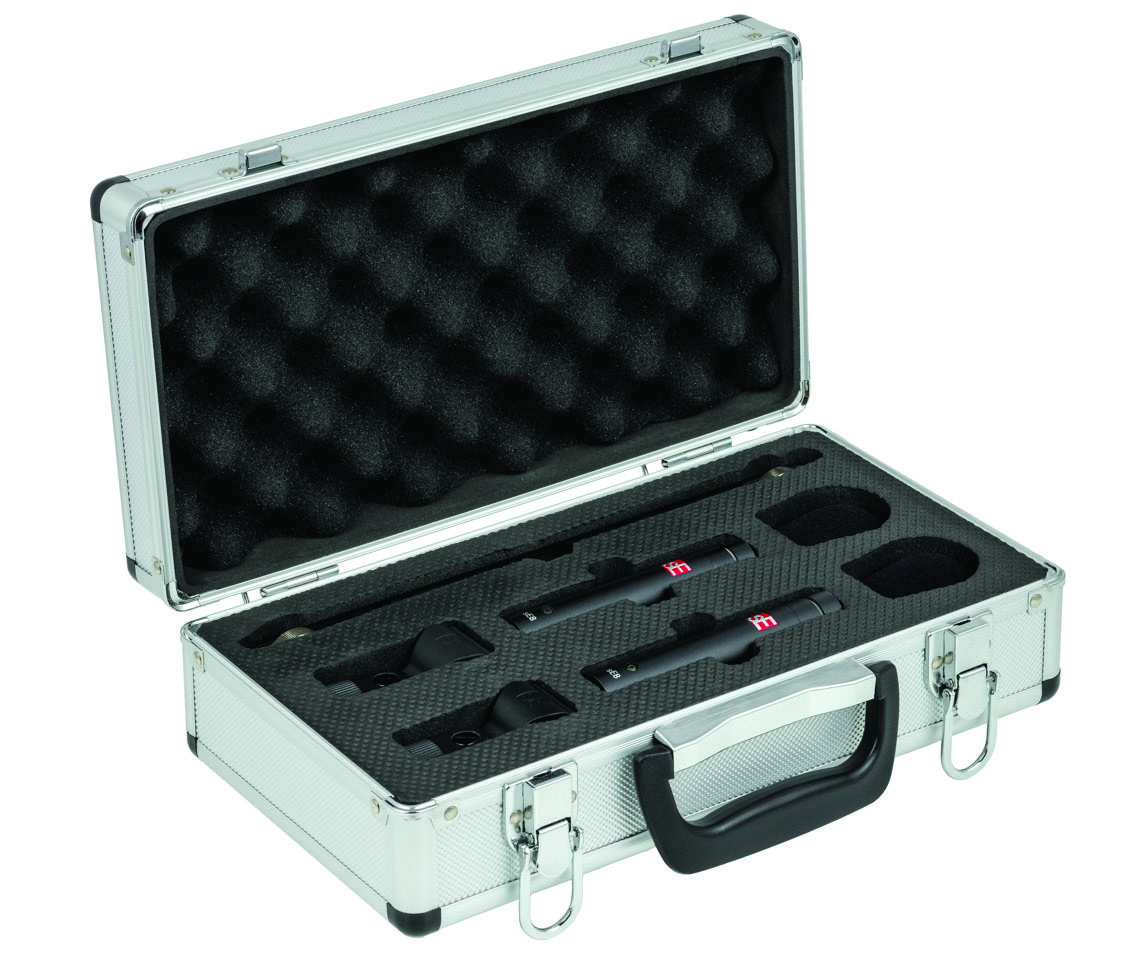
I had a pair of sE8s for the review and used them across many sessions. The mic is fixed-cardioid, front-address with some nice extras. It offers two low-cut filters (switchable between 80 and 160 Hz) and two attenuation pads (-10dB or -20dB). I employed the pads depending on the situation.
I’m always experimenting with slim, front-address microphones around a drum kit because they’re so easy to place. I used the sE8s as overheads, as a close-mic for a ride cymbal and on hi-hat, and they were reminiscent of some of the best condensers I’ve used, some much more expensive. Cymbals sounded clear without being strident, and the mics reproduced transients admirably. Stick hits on the cymbals, toms and snare were clear and easy to position in the mix with the rest of the elements.
Next, I used the pair of sE8s over the hammers on a Yamaha Grand piano. A third mic, an AKG D19, was placed close to the resonant wooden bed of the piano directly beneath the third sound hole from the back of the piano. This third mic was panned center and overly compressed, which when blended with the two other mics added a beautiful presence to the piano in the track. The pair of sE8s provided an impressive stereo picture of the instrument, easily handling the transients when the instrument was played hard.
A single sE8 worked very well capturing acoustic guitar. I blended the low-to-high frequency ratio needed by simply moving the mic closer or farther away from the sound hole. I also played with the proximity effect to thin out the boomy-ness of the instrument; when I wanted a more intimate sound closer to the strings, I employed the 80Hz or even 160Hz rolloffs to tailor the low end to taste. Pairing placement tricks with the rolloffs provided more than enough tools to get the job done.
The sE8s are pro-quality transducers at an entry-level price. Having these great utility mics in your locker is a must if you’re trying to build an array of tools for making great recordings on a budget.
PRODUCT SUMMARY
COMPANY: sE Electronics
PRODUCT: sE8
WEBSITE: seelectronics.com
PRICE: $249 (single); $499 (pair)
PROS: Even and smooth sonic capture, not harsh at the top end. Excellent storage case and stereo bar included.
CONS: None
EHRLUND EHR-T
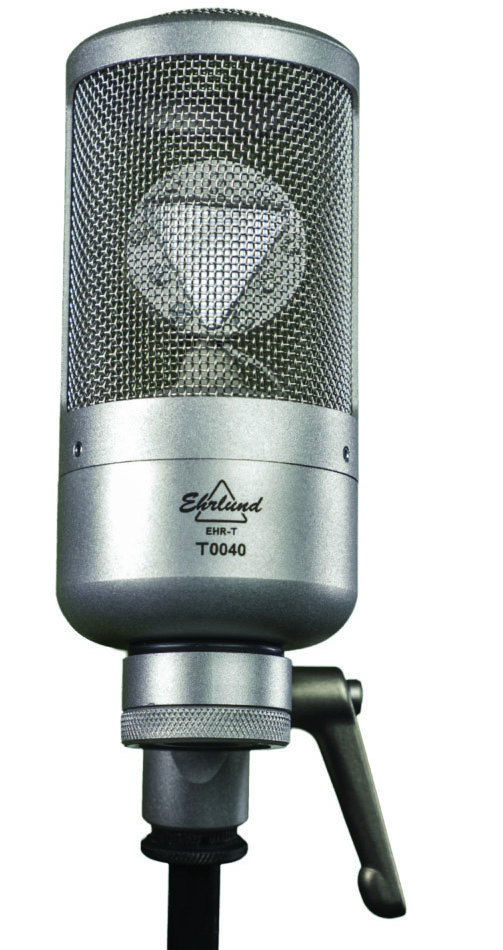
I’m a big fan of innovative mic design, especially when capsule makers retreat from the common circular diaphragm. I’ve reviewed both the Pearl ELM-C and Audio-Technica AT5045, which use a rectangular capsule. They are stellar examples of how unusual capsules can provide excellent results. The EHR-T from Ehrlund uses a triangular-capsule design, a shape that seems to bring improved resonance and damping to this excellent transducer.
The EHR-T is not new. It’s a double-capsule version of Ehrlund’s EHR-M, where the fixed-cardioid polar pattern and diaphragms are the same. The EHR-T has a single 5-pin XLR at its output that connects to a provided splitter cable that ports each capsule to separate 3-pin XLRs. I found myself having to test the mic and mark the cables with tape and a Sharpie to designate proper outputs, which are not marked. This was not a problem, but it would be nice if the manufacturer made this more apparent.
I first used the mic as a mono overhead placed in the center of two spaced overheads, then on a later session as a room mic placed six feet back from the kit. I’ve used this technique with dual-output mics in the past, most notably the Lewitt 640TS. With the EHR-T, I cut both capsules to separate mono tracks in Pro Tools and then blended the direct with the off-axis signal to taste. This works great when trying to blend more of the room with the kit. The EHR-T’s impressive off-axis response makes the front and rear feed easy to mix because like a mic in Omni, all signals reach the capsules at the same time. However, unlike an omnidirectional mic, the EHR-T allows you to alter the gain of the front and back separately which offers a lot of flexibiity. It also stands up great as a single-point source mono overhead without the stereo overheads if you’re trying to tuck the kit into mono. The EHR-T held up better in the mix than panning the stereo overheads both to center.
The EHR-T continued to impress when used as a close mic on a snare drum without employing the back capsule. I also liked it on acoustic guitar—you get the body of a large-diaphragm mic, plus the extended top end you’d expect from a smaller capsule. I found that this “hybrid” effect worked the same in other applications. For example, when I used it in a live chamber, I got all the accurate high-frequency cues plus the bloom of the mids and lows you’d expect from a real resonant cavity. The mic also worked very well when recording hand percussion like tambourine, shaker and assorted noise-makers. The EHR-T’s natural-sounding transients and excellent high-frequency reproduction made these instruments sound as you’d expect if you were standing in the room. This is not a small task with other mics, which may bring harshness, especially at hotter levels.
My only problems with the EHR-T have nothing to do with the excellent mic, it’s the poor presentation. The box the mic comes in is not suitable for a mic that’s priced well over $2k. It is a thin, unfinished, foam-lined wooden box with a sliding lid that isn’t large enough to store the essential multipin splitter cable. I can see this causing the cable to go missing, making the mic unusable. Also, the EHR-T would benefit from some kind of software tool allowing you to use the twin outputs creatively, like Lewitt’s excellent Polarizer plug-in. While the EHR-T is an excellent mic and would benefit any mic locker, it falls short in presentation for a high-end transducer in this price range.
PRODUCT SUMMARY
COMPANY: Ehrlund Microphones
PRODUCT: EHR-T
WEBSITE: ehrlund.se
PRICE: $2,699
PROS: Sonically excellent large-diaphragm condenser. Natural-sounding reproduction.
CONS: Unable to store split cable and mic in the poorly built storage box. Output cables are not marked (front/back).

